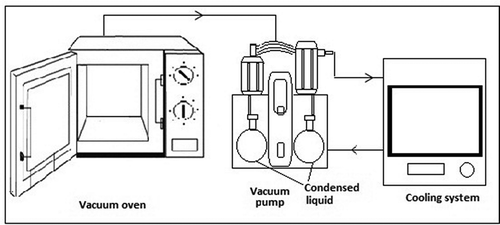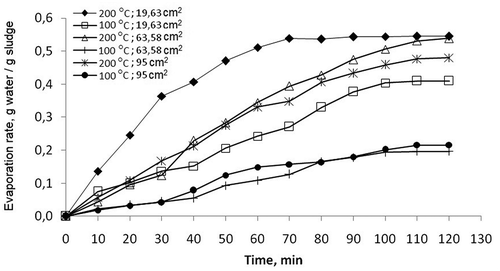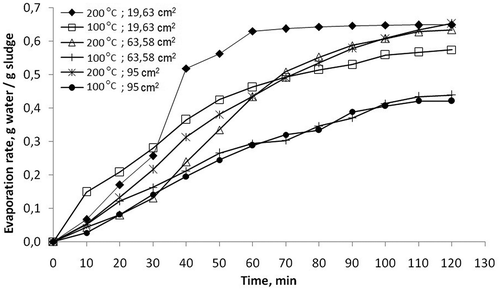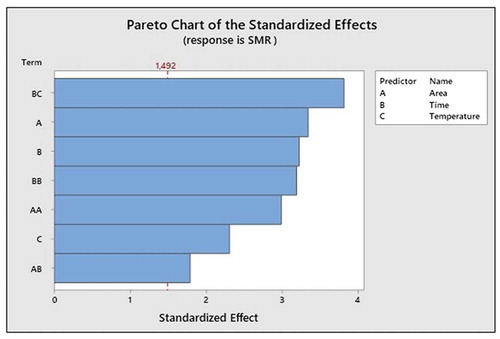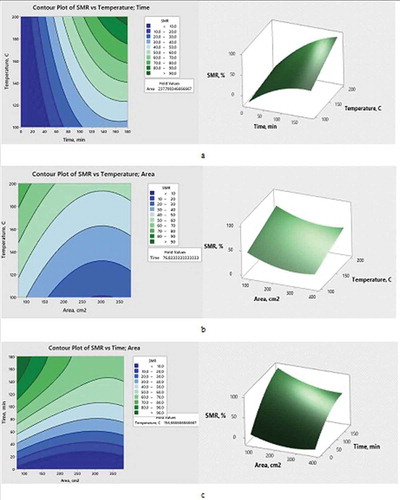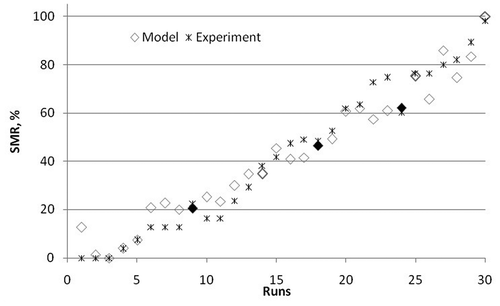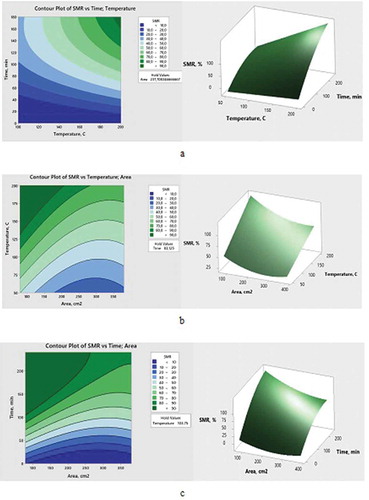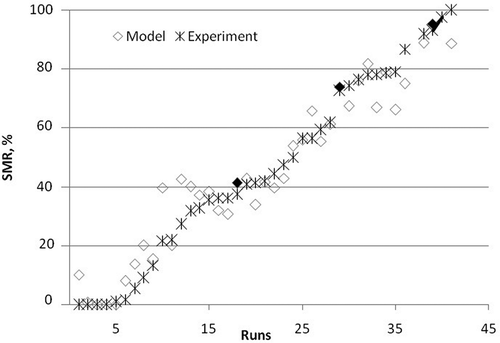 ?Mathematical formulae have been encoded as MathML and are displayed in this HTML version using MathJax in order to improve their display. Uncheck the box to turn MathJax off. This feature requires Javascript. Click on a formula to zoom.
?Mathematical formulae have been encoded as MathML and are displayed in this HTML version using MathJax in order to improve their display. Uncheck the box to turn MathJax off. This feature requires Javascript. Click on a formula to zoom.ABSTRACT
Sludge drying is one of the main problems of wastewater treatment plants. It is very important to facilitate the drying process in terms of drying efficiency, time duration, and cost of the processes, so that transportation and dumping of sludge will accordingly be realized effectively. In this study, vacuum assisted thermal drying was studied. Under vacuum conditions, the water content of the sludge was examined easier than at atmospheric pressure in the drying process. For this reason, in this study, time, temperature, and sludge mass surface area on drying efficiency were evaluated under two different pressure levels, such as 30 mbar and 1,000 mbar. To optimize these parameters, the Response Surface Methodology approach was utilized. Results showed that the effect of vacuum condition on sludge drying was remarkable at obtaining at least 65% of solid material ratio in sludge, which is the lowest limit value on landfilling legislation in Turkey. Data obtained from the study shows that, especially at high temperatures, contribution on sludge drying of vacuum condition is more effective in terms of drying time. A smaller sludge surface area is also found more significant on vacuum drying.
Implications: Drying the sludge under low pressure shortens the drying time. It is possible to reach higher solid material ratio under low pressure. Time, temperature, and surface areas of sludge are effective parameters in vacuum drying.
Introduction
Sludge is a byproduct of wastewater treatment for both domestic and industrial processes. Sewage sludge is an unwanted but inevitable byproduct of wastewater treatment process (Jinping, Jinhua, and Yunjiao Citation2016). Because of the high water content and some hazardous substances, sludge management becomes increasingly important in terms of environmental point of view. To handle large quantities of sludge, an effective approach is to reduce its volume by decreasing the water content as much as possible (Haberl and Salzer Citation1992; Teng et al. Citation2020; Zhong-Sen et al. Citation2019). The principle of sludge treatment is reduction, stabilization, harmlessness, and resourced utilization (Pina et al. Citation2019). Conventional wastewater treatment plants (WWTP) and some industrial treatment plants are also sources of high sludge quantities, which include a high number of pathogens, a high portion of water, and organic matter (Mawioo et al. Citation2017).
In general, sludge generated in domestic wastewater treatment plants has less than 8% solid material content (Anjum, Al-Makishah, and Barakat Citation2016). Also more than 50% of the total operating cost of wastewater treatment facilities comes from sludge management and its final disposal (Mowla, Tran, and Allen Citation2013; Pognani et al. Citation2011). For this reason, the efficient separation of liquid and solid in sludge will decrease the total cost of sludge disposal (Septien et al. Citation2020; Wei et al. Citation2018).
According to the Commission of European Community report, approximately 13 million tons of dry sludge will be produced worldwide by the year 2020 (European Union, Citation2010). The first step to reduce the volume and increase the solid content of sludge, thickening and then dewatering processes are applied. Dewatered sludge is easier to manage to further drying followed by final disposal alternatives. To carry out dewatering and drying of treatment plant sludge, some different technologies have been developed. These technologies include direct or indirect flotation, thickening table, thickening drum, screw drum, and centrifuge for thickening processes, belt filter, vacuum filter, membrane filter, centrifuge, frame filter press for dewatering processes, and land use, landfill, and incineration methods for final disposal (Ki-Tae, Byung-Ran, and Soo-Koo Citation2010; https://www.snf.us).
Land farming (direct or after composting), incineration (after drying), recycling in cement production, and sludge landfilling processes were used generally in the European countries (Kelessidis and Stasinakis Citation2012). In addition to these methods, nowadays some new technologies are also applied such as wet oxidation, supercritical water, and pyrolysis combustion (Collard et al. Citation2017), ultrasound-assisted hot air convective drying (Mou and Chen Citation2020), and sludge drying with resin (Kobayashi et al., Citation2020a; Kobayashi et al. Citation2020b). Also sludge drying was enhanced for some pre-conditioning facilities using biomasses and pulverized coal (Zhao et al. Citation2019).
Dried sewage sludge has a calorific value of 11.1–22.1 MJ/kg, which is comparable to or higher than that of lignite and various biomass samples. Therefore, due to energy deficiency in the world, sludge especially originating from domestic wastewater treatment plants can be considered as alternative fuel or fuel additive instead of landfilling (Seok, Byung, and Soo Citation2018).
Thickening, dewatering, and drying processes are vital in sludge management as explained. Among all three steps mentioned, especially the dewatering process prior to drying is a critical step for further disposal as it directly affects the transportation and drying costs.
As of the final disposal techniques of sludge, various drying processes have been developed and being used. Especially thermal drying such as solar, conventional heating, heat pump drying (Ploteau et al. Citation2019), and microwave irradiation processes are common applications. All have some advantages and disadvantages. For instance, the solar drying process is cost effective but needs considerable time and area, while microwave irradiation is the fastest and also allows stabilization of sludge in terms of pathogen microorganisms together with drying, but it is expensive as it uses electricity.
Providing thermal energy is necessary if dehydrating the sludge is needed. In the future, heat drying techniques are expected to be the leading methods for the drying of municipal or industrial sludge. As an advanced deep dehydration technique, heat drying has been used worldwide. The method using only electric heating to reduce water content of sludge is not viable in regard to the energy economy. To make this method more useful or considerable in terms of energy consumption, reduced pressure conditions could be used so that the evaporation temperature of water is reduced under vacuum conditions resulting in lower energy consumption. The underlying reason is thought to be the fact that thermal hydrolysis involves the use of heat and/or pressure treatment improves sludge digestibility (Jumoke et al. Citation2019). In another study under vacuum conditions at 40°C–80°C temperatures activated sludge reached at high solid dry ratio (Hippinen and Ahtila Citation2004).
Drying is the most important application for treated sludge to decrease its water content. Therefore, reducing water content of sludge causes high calorific value and low sludge volume. There are many methods to dry sludge. These are mechanical drying, drying beds, solar drying, bio-drying, and thermal drying (convective drying, hot air drying, and microwave drying). Some advantages and disadvantages of these methods exist. For example, in the mechanical drying process, high solid content cannot be reached in general. Drying beds and solar drying processes need a large area and a long time. Bio-drying also needs much more time and precise application. Apart from all these methods, the most effective method to dry sludge is thermal drying. Thermal drying can be done in a shorter time, and additionally, this method has proven itself and provides an effective high enough solid matter rate. Because of these reasons, the thermal drying of sludge application is a widely used process. The most obvious disadvantage of thermal drying is electricity consumption and therefore cost. To eliminate this undesirable status, many additional contributions have developed.
In this study, a vacuum assisted thermal dying process was utilized. The main aim of this study is to bring the sludge drying process as cost friendly. With this study, sludge will be dried by providing evaporation of water at lower temperatures under vacuum conditions. Thus, it will not be necessary to go to high temperatures to remove the water from the sludge and the drying costs will be reduced to reasonable levels. A comparative set of experiments was carried out to analyze the use of vacuum conditions for faster or efficient drying of the sludge.
Material and methods
Experimental setup
In this study all of the experiments were carried out in the batch vacuum assisted thermal drying system as illustrated in . Sludge used in the study was the filter press cake sludge obtained from the wastewater treatment plant of an organized settlement of metal plating industries. The chemical treatment plant removes heavy metals such as Cr+6, Ni+2, Cu+2, and Zn+2. To remove these metals, first the Cr+6 is reduced to Cr+3, and then all remaining metals are settled by adding lime and polyelectrolyte chemical. The sludge used in this study is the cake sludge that is precipitated after flocculation in the facility and comes out of the filter press unit. A vacuum oven (Nuve-Turkey, EV-018) was used for heating under vacuum. Vacuum was applied by a vacuum pump system (KNF-Germany, SC-920 G), which also condenses and accumulates the evaporated water for further analysis. The vacuum pump system was capable of generating ultimate vacuum pressure of 2 mbar absolute with a delivery of up to 20 L/min suction volume at atmospheric pressure. The synthesis liquid which is evaporated and condensed in the suction-and-pressure sides of the vacuum pump contains water and some volatile organics. The chemical composition of this liquid also reflects the volatile organic of the sludge. A condenser (Guangzhou Teyu Electromechanical Co., Ltd., CW–5000) operating at 5°C was used in the experimental setup to cool and collect the drying vapors (synthesis liquid).
Experimental data of the parameters of drying time, temperature, pressure (vacuum level), and sludge mass surface area were recorded during drying experiments either as set values or variation data. The drying efficiency (water content of the sludge) was evaluated by measuring the weight of sludge samples at different time intervals throughout each drying experiment. An optimization method called Response Surface Methodology (RSM) was used to optimize time, temperature, and surface area of sludge at two different pressures. In statistics, RSM explores the relationships between several explanatory variables and one or more response variables. The main idea of RSM is to use a sequence of designed experiments to obtain an optimal response.
Results and discussions
The experimental matrix of the study was given in . The moisture content of raw sludge was nearly 65%, and solid material ratio (SMR) value is 35%. This moisture content is high enough for both transportation and landfilling in terms of cost and dumping area requirement both of which should be minimized as much as possible.
Table 1. Experimental study matrix
Determination of optimum drying temperature
Three temperature values of 50°C, 100°C, and 200°C were examined and SMR of sludge were analyzed with respect to time under 30 mbar vacuum and 1,000 mbar atmospheric pressure. The effect of free surface area of drying sludge mass available for evaporation was also considered as 19.63 cm2, 63.58 cm2, and 95 cm2 with the same thickness of it (1 cm). Optimization of experimental parameters of temperature, time, and surface area was investigated, and the results obtained were evaluated on the RSM model.
Experimental study matrix was first formed as in . All of the studies during the experimental period were followed in accordance with to get high enough SMR in the sludge. Since both transportation and landfilling of sludge with high water content are not reasonable in terms of cost and environmentally friendly, the minimum SMR was aimed as 65% in this study to get enough strength pile in landfill area according to the landfilling regulation in Turkey. Experiments were set as 120 min duration of drying process. Since 1,000 mbar pressure with 50°C temperature conditions did not give reasonable drying results, data of these experiments were expressed as N.A. (i.e., not available) in . Low temperature (50°C) in this study is only significant under 30 mbar vacuum pressure level. Studies were carried out in different time periods for each temperature. For this reason, although the diameters were the same, there were small differences in the sludge weights, as can be seen from .
Evaporation rates of water from sludge at different experimental conditions were given in for a-1,000 mbar pressure level. Since 1,000 mbar pressure with 50°C temperature conditions did not give reasonable drying results, the data of these experiments was not evaluated in .
As can be seen from , drying at 200°C resulted in higher evaporation rates for all of the surface areas of sludge. Smaller surface area gives higher evaporation rate for both 200°C and 100°C. This could be explained by the amounts of masses of sludge given in . As the amount of sludge increases, heat capacity increases and average temperature of the sludge decreases and this eventually leads to lower evaporation rates. The vacuum effect was realized at 30 mbar absolute pressure, and corresponding evaporation rates were given in .
Upon comparing , it is clear that the 30 mbar vacuum condition accelerates the evaporation of sludge water faster than the 1,000 mbar pressure condition. Vacuum assisting makes drying reach the highest level at 200°C in one hour. In this operating condition, as can be seen in , both time is saved and the SMR value can reach a maximum level of 65% , namely that it is not only for time but also for SMR value reaching the highest degree almost as 65%. Considering the error distributions among the measurements, it was determined that the highest is 5.5% and the lowest is 0.85%. shows also that a small sludge surface area gives high evaporation rate. According to the unit abscissa parameter, there is sludge mass in denominator. Low surface area means low mass and evaporation rate is fast as well. Additionally, heat transfer to a small surface area (lighter sludge mass) is easier and occurs in a short time than in a large surface area (heavier sludge mass).
To evaluate the optimum drying conditions of the study, many parameters affecting each other should be considered. RSM approach was used to determine optimum conditions in terms of time, sludge surface area, and temperature. All of the parameters were evaluated for two different pressure levels as 1,000 mbar and 30 mbar in RSM to optimize parameters to get high enough SMR.
RSM study with 1000 mbar
Atmospheric pressure value of 1,000 mbar was first experienced at three different temperatures as 50°C, 100°C, and 200°C with different sludge surface areas of 19.63 cm2, 63.58 cm2, and 95 cm2 to find out or compare the effect of vacuum as 30 mbar. Results of RSM analyses are given in .
Table 2. RSM model summary of 1,000 mbar study
S value in represents the standard deviation and measured in the units of response in RSM. The value of R2 is the percentage of variation in the response that is explained by the model. R2(adj) value is the percentage of the variation in the response that is explained by the model adjusted for the number of predictors in the model relative to the number of observations. R2(pred) value given in represents how well the model predicts the removed observation. In accordance with the model results, the regression equation was obtained and given in EquationEq. (1) for SMR of the sludge during the experimental study considering the effective parameters on sludge drying:
When analyzing the regression coefficient and EquationEq. 1 of RSM, confidence interval was observed more than 95%. Additionally, the interval between R2 and R2(adj) was obtained as very narrow, and this result shows that the RSM is useful for the experimental study. Variance analysis of the RSM study is also given in below.
Table 3. Analysis of variance of 1,000 mbar experiments
DF parameter in implies total degree of freedom that is related with the amount of information in our data. Adj SS value is expressed as adjusted sums of squares which are measures of variation for different components of the model. Adj MS parameter is expressed as adjusted mean squares that measure how much variation a term or a model explains, assuming that all other terms are in the model, regardless of the order they were entered. Unlike the adjusted sums of squares, the adjusted mean squares consider the degrees of freedom. F-value for the model is expressed as the test statistic used to determine whether the term is associated with the response. The p-value is a probability that measures the evidence against the null hypothesis. Lower probabilities provide stronger evidence against the null hypothesis.
To determine whether the model explains variation in the response, compare the p-value for the model to your significance level to assess the null hypothesis. The null hypothesis for the overall regression is that the model does not explain any of the variation in the response. Usually, a significance level (denoted as α or alpha) of 0.05 works well. A significance level of 0.05 indicates a 5% risk concluding that the model explains variation in the response when the model does not.
The condition of P < .05 means that results are statistically significant. In this study, P < .001 is realized meaning that results obtained in the study are in the confidence interval near 100%.
In the RSM method, parameters used in the model can be presented in Pareto graphs. These graphs show the effect of degrees of experimental parameters during optimization period either positive or negative effect on drying. The Pareto graph which expresses the most effective parameters in RSM for 1,000 mbar was achieved and is presented in .
A Pareto chart is a special type of bar chart where the plotted values are arranged from largest to smallest. Use a Pareto chart to identify the most frequently occurring defects, the most common causes of defects, or the most frequent causes of customer complaints.
As seen in the Pareto graph given in , the most effective parameters on sludge drying come out to be the area of sludge surface and time. Effects of these two parameters are greater on drying than temperature. Besides, all of the parameters given in pass the standardized effect value of 1.492. This means that all of the parameters are more or less effective on sludge drying and these parameters are necessary for the RSM model.
To see the degree of effect of the parameters, the results achieved from the optimization with RSM were given in as contour and three-dimensional (3D) surface graphs. These graphs were formed by RSM in accordance with the parameters of time, temperature, and sludge surface area.
shows the effectiveness of binary combination of these three parameters. While obtaining more than 90% of SMR content especially in and c, in this value was determined as maximum up to 70% of SMR. More fluctuation is also seen in for SMR value. The reason for this can be explained in that the parameters of time and area are more effective on SMR individually. Showing them in the same graph is the main reason for that. Although the area and temperature parameters are given in , this binary combination does not show considerable effect on SMR. Therefore, RSM did not visualize them automatically in the Pareto graph.
The predicted results generated by the RSM model and the experimental one were compared in . As can be seen from , both predicted and experimental results are fitted well for 1,000 mbar pressure level.
RSM study with 30 mbar
The 30 mbar vacuum pressure was studied to see the effect of vacuum condition on drying. The same temperature values (i.e., 50°C, 100°C, and 200°C) and the same sludge surface area values (i.e., 19.63 cm2, 63.58 cm2, and 95 cm2) were examined in this pressure level for the comparison to 1,000 mbar experiments. Optimization of sludge drying parameters and its values were obtained by RSM. Regression equation of the model was given in EquationEq. (2), and model summary values are given in :
Table 4. RSM model summary of 30 mbar study
The interval between R2 and R2(adj) given in was obtained as very close to each other, and this result implies that usage of RSM method for this experimental study is meaningful. The regression coefficient of 94% is also significant enough.
The P value is less than 0.05 in meaning that the results are statistically significant. Results obtained from 30 mbar vacuum drying experiments stay in confidence intervals near 100%.
Table 5. Analysis of variance of 30 mbar experiments
Data of the experiments conducted at 30 mbar were analyzed and optimized by the RSM model, and the effective parameters on drying were evaluated as Pareto graph as shown in .
The most effective parameter on sludge drying was obtained to be time. The second and the third effective parameters were area of sludge surface and temperature, respectively. Moreover, all of the parameters given in are greater than the standardized effect value of 1.476. This means that all of the parameters are more or less effective on sludge drying and necessary for the RSM model.
To understand better the Pareto graph given in , optimization parameters for the combinations of all of three variables (i.e., time–temperature, time–surface area, temperature–surface area) were evaluated and given in . This figure shows the most optimum variable values in the forms of binaries to get high SMR.
While obtaining more than 90% of SMR content especially in and c, this value was not determined in as much as and c.
Compatibility of the experimental data and predicted results of RSM are shown in in terms of SMR. Although some fluctuations are observed in , compliance for both predicted and experimental data are noted in general in high enough ratios for the 30 mbar study.
The highest SMR value was obtained at a-30 mbar vacuum condition meaning that vacuum condition could contribute especially in terms of drying time duration in the sludge drying process. Another contribution of vacuum condition may be noted as higher SMR value than atmospheric pressure condition of 1,000 mbar. In this study, it was determined that higher SMR values were found in sludge samples with small surface areas. This finding is available for two different pressure levels at 200°C temperature.
Conclusion
The RSM approach shows that experimental and model results for two pressure levels are compatible. Low temperature is very important in terms of applicability on sludge drying especially in terms of energy cost. The main aim of this study is also to decrease temperature and time values under low pressure ambient to get minimum 65% of SMR value of sludge to landfill it in Turkey according to the legislation. Decreasing pressure (i.e., generating higher vacuum) level utilizes higher SMR values at low temperature and also in a short time.
When considering EquationEq. (1) and (Equation2
) obtained from RSM according to results of this study, especially at high temperatures, contribution on sludge drying of vacuum condition is more effective. While at high temperatures, e.g., 200°C, the time interval is 30.3% shorter under 30 mbar vacuum condition than 1,000 mbar in terms of getting 65% of SMR value which means minimum SMR value to landfill solid waste like sludge into dumping area in Turkey. This situation is just 16.4% for 75°C. Although low pressure value (30 mbar) is more effective than high pressure value (1,000 mbar) for all of the temperature values, this contribution of low pressure is more meaningful at high temperatures on sludge drying.
The experimental results also showed that smaller surface area gave better SMR values on sludge drying. Because of this reason, the optimum surface area in this study was determined as 19.63 cm2 for both 1,000 mbar and 30 mbar pressure conditions. According to the study, a smaller surface area gives a better drying result. According to the RSM model results, when 19.63 cm2 and 95 cm2 were compared at 200°C drying temperature to get 65% of SMR value, it was determined that 19.63 cm2 study shortened drying time by 35% and 72% for 1,000 mbar and 30 mbar pressure levels, respectively.
Acknowledgment
This study is supported by Yildiz Technical University Office of Scientific Research Project Coordination with reference number of FBA-2018-3480 and name of Investigation of The Drying Characteristics of The Industrial Treatment Sludge with The Vacuum Drying Process.
Disclosure statement
No potential conflict of interest was reported by the authors.
Additional information
Notes on contributors
Yasar Avsar
Yasar Avsar is a corresponding author. He is professor at Yildiz Technical University, Civil Faculty Environmental Engineering Department 34220 Istanbul - Turkey. He is an expert on wastewater treatment, sludge management and advanced oxidation processes. He can be contacted at [email protected] or [email protected].
Arslan Saral
Arslan Saral is a professor at Yildiz Technical University, Civil Faculty Environmental Engineering Department 34220 Istanbul - Turkey. He is an expert on air pollution and its control systems. He can be contacted at [email protected].
Fatih Ilhan
Fatih Ilhan is an assistant professor at Yildiz Technical University Civil Faculty Environmental Engineering Department 34220 Istanbul - Turkey. . He is an expert on wastewater treatment. He can be contacted at [email protected] or http://avesis.yildiz.edu.tr/filhan website.
Bahar Akyuz
Bahar Akyuz is a doctoral student at Yildiz Technical University Civil Faculty Environmental Engineering Department 34220 Istanbul - Turkey. She is an expert on sludge drying and management systems. She can be contacted at [email protected].
Mustafa Talha Gonullu
Mustafa Talha Gonullu is a professor at Yildiz Technical University, Civil Faculty Environmental Engineering Department 34220 Istanbul - Turkey. He is an expert on wastewater treatment, industrial pollution control, advanced oxidation processes. He can be contacted at [email protected].
References
- Anjum, M., N. H. Al-Makishah, and M. A. Barakat. 2016. Wastewater sludge stabilization using pre-treatment methods. Process Saf. Environ. Times. 102:615–32. doi:https://doi.org/10.1016/j.psep.2016.05.022.
- Collard, M., B. Teychen, and L. Lemee. 2017. Comparison of three different wastewater sludge and their respective drying processes: Solar, thermal and reed beds e Impact on organic matter characteristics. J. Env. Man. 203:760–67. doi:https://doi.org/10.1016/j.jenvman.2016.05.070.
- Haberl, R., and C. Salzer. 1992. Dewatering of sewage sludge with vacuum assisted sludge dewatering beds. Wat. Sci. Tech. 26 (9–11):2273–76. doi:https://doi.org/10.2166/wst.1992.0714.
- Hippinen, I., and P. Ahtila. 2004. Drying of activated sludge under partial vacuum conditions - An experimental study. Drying Technol. 9:2119–34. doi:https://doi.org/10.1081/DRT-200034247.
- Jinping, L., G. Jinhua, and H. Yunjiao. 2016. Characteristics of heavy metal species transformation of Pb, Cu, Zn from municipal sewage sludge by thermal drying. Procedia Environ. Sci. 31:961–69. doi:https://doi.org/10.1016/j.proenv.2016.03.001.
- Jumoke, O., S. Kaiqi, L. Xiang, Y. Gang, and W. Tao. 2019. Review: A review of sludge-to-energy recovery methods. Energies 12:60. doi:https://doi.org/10.3390/en12010060.
- Kelessidis, A., and A. S. Stasinakis. 2012. Comparative study of the methods used for treatment and final disposal of sewage sludge in European countries. Waste Man 32:1186e1195. doi:https://doi.org/http://dx.doi.10.1016/j.wasman.2012.01.012.
- Ki-Tae, P., L. Byung-Ran, and L. Soo-Koo. 2010. Drying characteristics of sewage sludge using vacuum evaporation and frying. J. Mater. Cycles Waste Manag. 12:235–39. Springer 2010. doi:https://doi.org/10.1007/s10163-010-0293-x.
- Kobayashi, N., K. Okada, Y. Tachibana, K. Kamiya, B. Zhang, A. Suami, T. Nakagawa, and Y. Itaya. 2020b. Drying enhancement of sludge with resin-type drying accelerator and its mechanism. Drying Technol. doi:https://doi.org/10.1080/07373937.2020.1725770.
- Kobayashi, N., K. Okada, Y. Tachibana, K. Kamiya, T. Ito, H. Ooki, B. Zhang, A. Suami, and Y. Itaya. 2020a. Drying behavior of sludge with drying accelerator. Drying Technol. 38 (1–2):38–47. doi:https://doi.org/10.1080/07373937.2019.1605611.
- Mawioo, P. M., H. A. Garcia, C. M. Hooijmans, K. Velkushanova, M. Simonič, I. Mijatović, and D. Brdjanovic. 2017. A pilot-scale microwave technology for sludge sanitization and drying. Sci. Total Environ. 601–602:1437–48. doi:https://doi.org/10.1016/j.scitotenv.2017.06.004.
- Mou, X., and Z. Chen. 2020. Experimental study on the effect of sludge thickness on the characteristics of ultrasound-assisted hot air convective drying municipal sewage sludge. Drying Technol. 1–13. doi:https://doi.org/10.1080/07373937.2020.1716243.
- Mowla, D., H. N. Tran, and D. G. Allen. 2013. A review of the properties of biosludge and its relevance to enhanced dewatering processes. Biomass Bioenergy. 58:365–78. doi:https://doi.org/10.1016/j.biombioe.2013.09.002.
- Pina, A., P. Ferrão, J. Fournier, and B. Lacarrièr. 2019. Coupling heat pump and vacuum drying technology for urban sludge processing. Energy Procedia 158 (9):1804–10. doi:https://doi.org/10.1016/j.egypro.2019.01.424.
- Ploteau, J. P., H. Noel, A. Fuentes, P. Glouannec, and S. Louarn. 2019. Sludge convection drying process: Numerical modeling of a heat pump assisted continuous dryer. Drying Technol. doi:https://doi.org/10.1080/07373937.2019.1630425.
- Pognani, M., R. Barrena, X. Font, F. Adani, B. Scaglia, and A. Sanchez. 2011. Evolution of organic matter in a full-scale composting plant for the treatment of sewage sludge and biowaste by respiration techniques and pyrolysis-GC/MS. Bioresour. Technol. 102 (6):4536–43. doi:https://doi.org/10.1016/j.biortech.2010.12.108.
- Salado, R., Vencovsky, D., Daly, E., Zamparutti, T., Palfrey, R. 2010. Environmental, Economic and Social Impacts ofthe use of Sewage Sludge on Land; Part II: Report on Options and Impacts; Report by RPA; EuropeanCommission, DG Environment: Brussels, Belgium.
- Seok, H. K., R. L. Byung, and K. L. Soo. 2018. Drying characteristics of thickened sewage sludge in oil vacuum evaporation system. Mat. Cycles Waste Man. 20:1085–89. doi:https://doi.org/10.1007/s10163-017-0671-8.
- Septien, S., S. W. Mirara, B. S. N. Makununik, A. Singh, J. Pocock, K. Velkushanova, and C. A. Buckley. 2020. Effect of drying on the physical and chemical properties of faecal sludge for its reuse. J. Env. Chem. Eng. doi:https://doi.org/10.1016/j.jece.2019.103652.
- Teng, W., H. Shuangshuang, F. Tianming, L. Jinping, Z. Xian, X. Yongjie, and H. Haobo. 2020. Effects of electromagnetic induction on migration and speciation of heavy metals in drying sewage sludge: Mechanistic insights. Waste Manage. 109:192–201. doi:https://doi.org/10.1016/j.wasman.2020.05.005.
- Wei, H., B. Gao, J. Ren, A. Li, and H. Yang. 2018. A review coagulation/flocculation in dewatering of sludge. Water Res. 143:608–31. doi:https://doi.org/10.1016/j.watres.2018.07.029.
- Zhao, L., J. Yang, S. Wang, and Z. Wu. 2019. Co-drying characteristics of sticky sewage sludge pre-conditioned with biomass and coal. Drying Technol. doi:https://doi.org/10.1080/07373937.2019.1692861.
- Zhong-Sen, L., T. Lian-Sheng, Z. Long-Jian, and L. Zhen-Gui. 2019. Dewatering sludge by osmotic technique – A comparative experimental study. Drying Technol. 37 (6):680–90. doi:https://doi.org/10.1080/07373937.2018.1454939.

